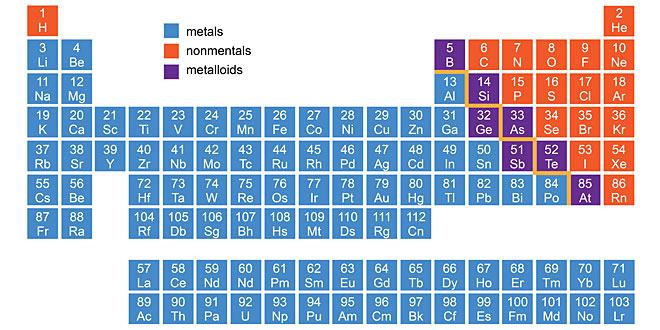Question: Give reason
i. Metals replace hydrogen from dilute acids, where as non-metals do not.
ii. Carbonate and sulphide ores are usually converted into oxides during the process of extraction.
Answer:
i. Metals are electropositive in nature. They readily lose electrons. These electrons reduce the protons liberated from the acid to liberate hydrogen gas, where as non-metals possess a tendency to gain electrons and hence they do not furnish electrons to protons liberated from acids. Hence H2 gas is not liberated.
ii. As it is easier to reduce metal oxides to metal, prior to reduction, metal sulphides and carbonates must be converted to oxides.
Question: Differentiate between metals and non-metals on the basis of their chemical properties.
Answer: Metals:
- Oxides of metals are either basic in nature or both basic and acidic in nature.
- Metals are electropositive in nature.
- Metals replace hydrogen from dilute acids.
- Metals react with water and produce a metal hydroxide or oxide and hydrogen gas.
Non-metals:
- Oxides of non-metals are either acidic or neutral.
- Non-metals are electronegative in nature.
- Non-metals do not replace hydrogen from dilute acids.
- Non-metals do not react with water or steam to evolve H2 gas as they cannot give electrons to hydrogen ions of water.
Question: Name a non-metallic element, which conducts electricity.
Answer: Carbon in the form of graphite conducts electricity, as there is a free electron in each carbon atom, which moves freely in between the hexagonal layers.
Question: Which metals do not corrode easily?
Answer: Gold and platinum and other noble metals do not corrode in air.
Question: What are alloys?
Answer: Alloys are homogeneous mixtures of two or more metals, or a metal and a non-metal.E.g. steel, brass, bronze, etc.
Question: Name two metals that are found in nature in the free state.
Answer: Gold and platinum are found in the free state in nature.
Question: What is chemical process used for obtaining a metal from its oxide?
Answer: Reduction process.
Question: Name two metals, which can form hydrides with metals.
Answer: Sodium and calcium form stable hydrides on reacting with hydrogen.
Question: Does every mineral have a definite and a fixed composition? Explain.
Answer: Yes, every mineral has a definite and a fixed composition. Minerals are widely distributed in the earth’s crust in the form of oxides, carbonates, sulphides, sulphates, nitrates, etc. These minerals are formed as a result of chemical changes taking place during the formation of earth.
Question: Explain the meaning of malleable and ductile.
Answer: Malleable is being able to be beaten/hammered into thin sheets.
Ductile is being able to be drawn into thin wires.
Question: You must have seen tarnished copper vessels being cleaned with lemon or tamarind juice. Explain why these sour substances are effective in cleaning the vessels.
Answer: The sour substances such as lemon (or tamarind juice) contain acids. These acids dissolve the coating of copper oxide or basic copper carbonate present on the surface of tarnished copper vessels and make them shining red-brown again.
Question: Give an example of a metal which:
1. is a liquid at room temperature.
2. can be easily cut with a knife.
3. is the best conductor of heat.
4. is a poor conductor of heat.
Answer:
- Mercury is in liquid state at room temperature.
- Sodium and potassium are soft metals which can be easily cut with a knife.
- Silver is the best conductor of electricity.
- Mercury is a poor conductor of heat.
 Class Notes NCERT Solutions for CBSE Students
Class Notes NCERT Solutions for CBSE Students





